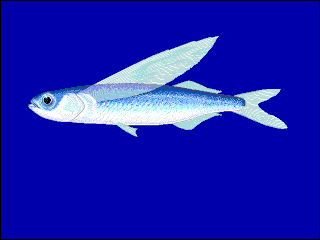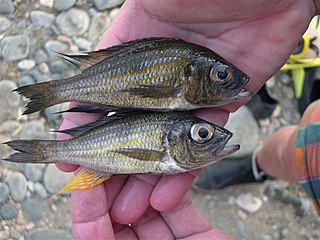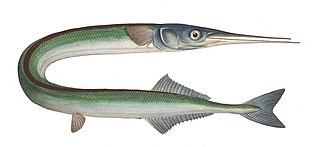Hemiramphidae is a family of fishes that are commonly called halfbeaks, spipe fish or spipefish. They are a geographically widespread and numerically abundant family of epipelagic fish inhabiting warm waters around the world. The halfbeaks are named for their distinctive jaws, in which the lower jaws are significantly longer than the upper jaws. The similar viviparous halfbeaks have often been included in this family.

Beloniformes is an order composed of six families of freshwater and marine ray-finned fish:

Aulonocranus dewindti is a species of cichlid endemic to Lake Tanganyika and some rivers which flow into it.
Cololabis is a genus of sauries found in the eastern and northern Pacific Ocean. The name is derived from the Greek word kolos, meaning 'short', and the Latin word labis, meaning 'forceps', referring to the short beak of the type species Scombresox brevirostris.
Nomorhamphus weberi is a species of viviparous halfbeak endemic to Lake Matano in Sulawesi, Indonesia. This species can reach a length of 7.5 centimetres (3.0 in) SL. The specific name honours the Dutch ichthyologist Max Carl Wilhelm Weber (1852-1937).
Tondanichthys kottelati is a species of viviparous halfbeak endemic to Indonesia, where it is only known from Lake Tondano near Mount Tondano in the far north of the island of Sulawesi. It grows to a length of 6.4 centimetres (2.5 in) SL. Despite being a member of the viviparous halfbeak family, this species is believed to be oviparous. This species was described in 1995 by Bruce Baden Collette and its species name honours the Swiss ichthyologist Maurice Kottelat.

Caesionidae, the fusiliers, are a family of marine ray-finned fishes in the order Perciformes. The family includes about 23 species. They are related to the snappers, but adapted for feeding on plankton, rather than on larger prey. They are found at reefs in the Indo-Pacific and in the Red Sea.

Anarhichas is a genus of marine ray-finned fishes belonging to the family Anarhichadidae, the wolffishes or sea wolves. These fishes are found in the northern North Atlantic and North Pacific oceans.

Belone is a genus of needlefish common in brackish and marine waters mainly found in the eastern Atlantic ocean to Mediterranean and Black Sea, as well. It is one of ten genera in the family Belonidae.

The grey gurnard is a species of ray-finned fish from the family Triglidae, the gurnards and sea robins. It is native to the eastern Atlantic Ocean, the Mediterranean Sea, and the Black Sea. It is caught as a food fish and is known for producing sounds. It is the only member of the monotypic genus Eutrigla.

Fodiator is a genus of flying fishes. It is the only genus in the subfamily Fodiatorinae.
Scomberesox is a genus of sauries. It is one of two in the family Scomberesocidae. The generic name Scomberesox is a compound of scomber and the Latin esox meaning pike.
The short-beaked garfish is an uncommon species of needlefish in marine waters of the eastern Atlantic Ocean. This pelagic needlefish is present off the coasts of Ireland, Spain, Portugal, and the United Kingdom, and possibly in the Mediterranean Sea, as well. This species was thought to be the same as the garfish because they share the same waters. The short-beaked garfish matures at 30 cm (12 in) and can grow to a maximum of 65 cm (26 in) while Belone belone can be 95 cm (38 in). Like all needlefish, this one has an elongated body with beak-like jaws that are lined with razor sharp teeth. The short-beaked garfish's lower jaw is longer than the upper. Its body is silvery like most needlefish and has a black stripe running across its lateral line. The dorsal and anal fins are very close to the caudal peduncle. These fish are oviparous. Eggs may be found attached to objects in the water by tendrils on the egg's surface. These spherical eggs are dispersed on the sea floor (demersal). Not much is known about this fish's feeding habits. It likely preys on small oceangoing fish. It has been caught using mackerel. Needlefish tend to be surface fish, so are preyed upon like Atlantic mackerel, European pilchard, sand smelt, etc. The specific name honours Anatolii Nikolaevich Svetovidov (1903–1985) who was an ichthyologist at the Zoological Institute in Saint Petersburg, Russia and a colleague of N.V. Parin.
Ratabulus is a genus of marine, demersal ray-finned fish belonging to the family Platycephalidae. These fishes are native to the eastern Indian Ocean and the western Pacific Ocean.

Mawson's dragonfish is a species of Antarctic dragonfish native to the Southern Ocean around Antarctica. It is found at depths of from 110 to 300 metres over the continental shelf. This species is the only known member of its genus.

Parachaenichthys is a genus of marine ray-finned fish belonging to the family Bathydraconidae, the Antarctic dragonfishes. They are found in the Southern Ocean around Antarctica.

Prionodraco is a monotypic genus of marine ray-finned fish belonging to the family Bathydraconidae, the Antarctic dragonfishes, its only species is Prionodraco evansii. These fishes are native to the Southern Ocean.

Chaetodipterus is a genus of marine ray-finned fishes belonging to the family Ephippidae, the spadefishes. These fishes are found in the Atlantic and eastern Pacific Oceans.
Nototheniops is a genus of marine ray-finned fishes belonging to the family Nototheniidae, the notothens or cod icefishes. The species in this genus are native to the Southern Ocean.
The bearded eelpout is a species of marine ray-finned fish belonging to the family Zoarcidae, the eelpouts. This species is the only species in the monospecific genus Lyconema. It is found in the eastern Pacific Ocean.











